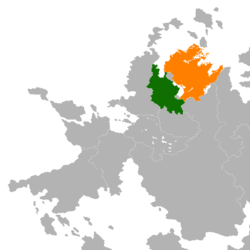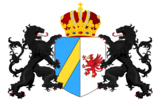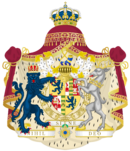Cuthland-Waldrich–Mascylla relations: Difference between revisions
No edit summary |
|||
| Line 53: | Line 53: | ||
| '''GDP (nominal)''' || $1.502 trillion || $2.126 trillion | | '''GDP (nominal)''' || $1.502 trillion || $2.126 trillion | ||
|- | |- | ||
| '''Military expenditures''' || | | '''Military expenditures''' || $61.8 billion || $46.8 billion | ||
|- | |- | ||
| '''Nuclear warheads<br>(active/total)''' || | | '''Nuclear warheads<br>(active/total)''' || ?/? || 390/450 | ||
|- | |- | ||
|} | |} | ||
Revision as of 15:43, 15 October 2020
 | |
[[Cuthland|]] |
Mascylla |
|---|---|
| Diplomatic mission | |
| Cutho-Waldish Embassy, Königsreh | Mascyllary Embassy, Kingsham |
| Envoy | |
| Ambassador X | Ambassador Peter Gottlieb |
The Cuthland-Waldrich–Mascylla relations or Cutho–Mascyllary relations refers to the bilateral relations between the Kingdom of Cuthland-Waldrich and the Crowned Republic of Mascylla. Relations between Cuthland-Waldrich and Mascylla and their respective predecessors, the Second Cuthish Empire and Cuthish State and the Mascyllary Kingdom, historically have been turbulent and pose an integral part of Berean and broader global politics.
Formal relations began with the establishment of the Mascyllary Kingdom in 1793 and were initially warm with Cuthland at that time, mainly due to the outcome of the Cuthish Revolutionary War in 1800. However, with the rise of the Second Cuthish Empire which had aspired to regain territories lost in the Partitions of Cuthland, relations with Mascylla soured significantly and culminated into the Second Cutho-Mascyllary War in 1839–41. The outcome of the war left the Mascyllary populous deeply infuriated and demoralised, and laid the foundation of the mutual hateship between both nations, which came to be known as Erbfeindschaft in Mascylla and heavily influenced foreign policy of Cuthland and Mascylla for a century, further exacerbating conflicts such as the Great War (1910–16) and the Melasian Crisis (1941–44) in which the two countries inflicted heavy warfare and defeats on one another. The subsequent Great Game amplified tensions amid a geopolitical struggle for political, economic and ideological superiority, though by repeating periods of hostility and détente.
In recent times, the relationship between Cuthland-Waldrich and Mascylla remains cold but tangible with official diplomatic and economic ties, and underwhent numerous short periods of tension and deterioration, such as during the Ochoccola War and the July 20 terrorist attacks in the 1990s and the intervention of Cuthland in the X in 20XX, with mutual sanctions thereafter. Experts often describe them as the "core countries" or "twin pendulum" of geopolitics.
Country comparison
| Kingdom of Cuthland-Waldrich | Crowned Republic of Mascylla | |
|---|---|---|
| Flag | ||
| Coat of arms | ||
| Area | 326,882 km2 (126,210 sq mi) | 542,017 km2 (209,273 sq mi) |
| Population | 44,793,500 | 48,972,336 |
| Capital | Kingsham (executive) Grienfjild (legislative and judicial) |
Königsreh |
| Largest city | Kingsham | Flussmund |
| Government | Federal parliamentary constitutional monarchy | Federal parliamentary constitutional monarchy |
| Head of state | King: Edwin IV | Queen: Dorothea I |
| Head of government | Foresitters: Clifford Goodwin and Ale Dykstra | Prime Minister: Thomas Falkner |
| Legislature | Wittenmoot Upper house: House of Lords Lower house: House of Burghers |
Parliament Upper house: Reichssenat Lower house: Reichsrat |
| Official language | Cuthish and Waldish | Hesurian |
| GDP (nominal) per capita | $33,536 | $43,417 |
| GDP (PPP) per capita | $41,248 | $48,901 |
| GDP (nominal) | $1.502 trillion | $2.126 trillion |
| Military expenditures | $61.8 billion | $46.8 billion |
| Nuclear warheads (active/total) |
?/? | 390/450 |



